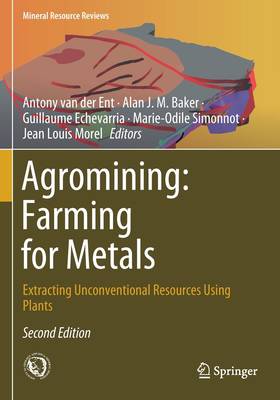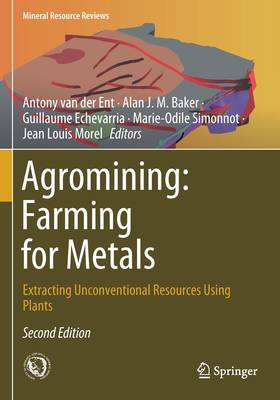
- Retrait gratuit dans votre magasin Club
- 7.000.000 titres dans notre catalogue
- Payer en toute sécurité
- Toujours un magasin près de chez vous
- Retrait gratuit dans votre magasin Club
- 7.000.000 titres dans notre catalogue
- Payer en toute sécurité
- Toujours un magasin près de chez vous
Agromining: Farming for Metals
Extracting Unconventional Resources Using Plants
116,45 €
+ 232 points
Description
This second and expanded edition of the first book on agromining (phytomining) presents a comprehensive overview of the metal farming & recovery of the agromining production chain. Agromining is an emerging technology that aims to transform the extraction of sources of target elements not accessible by traditional mining and processing techniques. Agromining, which is based on sustainable development, uses hyperaccumulator plants as 'metal crops' farmed on sub-economic soils or minerals wastes to obtain valuable target elements. This volume is edited and authored by the pioneers in the rapidly expanding field of agromining and presents the latest insights and developments in the field. This book provides in-depth information on the global distribution and ecology of hyperaccumulator plants, their biogeochemical pathways, the influence of rhizosphere microbes, the physiology and molecular biology of hyperaccumulation, as well as aspects of propagation and conservation of theseunusual plants. It describes the agronomy of metal crops and opportunities for incorporating agromining into rehabilitation and mine closure, including test cases for agromining of nickel, cobalt, manganese, arsenic, selenium, cadmium, zinc, thallium, rare earth elements and platinum group elements. Since the first edition was published, there have successful nickel agromining field trials in the tropics (in Malaysia and Guatemala), and these are presented in a dedicated case study chapter. Other new chapters focus on the processing of bio-ore for elements other than nickel, such as rare earth elements and cadmium, and on agromining from industrial wastes such as tailings, and industrial by-products and sites. Furthermore, the book features two new chapters that provide a comprehensive assessment of accumulation a very wide range elements from the Periodic Table in various plant species around the globe, and a chapter on practical methods for discovery of hyperaccumulator plantspecies in the field and in the herbarium. This book is of interest to environmental professionals in the minerals industry, government regulators, and academics.
Spécifications
Parties prenantes
- Editeur:
Contenu
- Nombre de pages :
- 489
- Langue:
- Anglais
- Collection :
Caractéristiques
- EAN:
- 9783030589066
- Date de parution :
- 09-12-21
- Format:
- Livre broché
- Format numérique:
- Trade paperback (VS)
- Dimensions :
- 178 mm x 254 mm
- Poids :
- 857 g

Les avis
Nous publions uniquement les avis qui respectent les conditions requises. Consultez nos conditions pour les avis.





